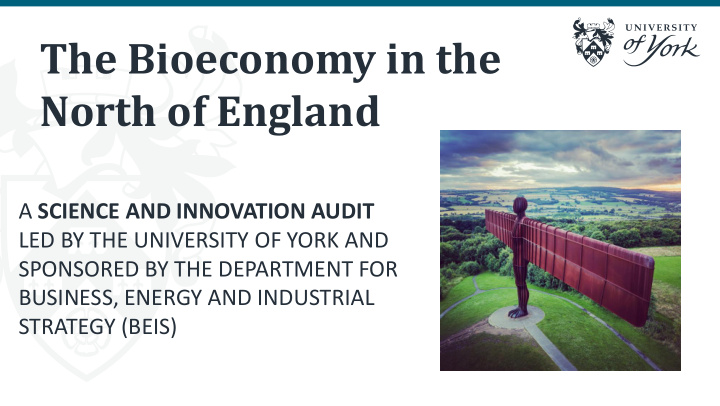



The Bioeconomy in the North of England A SCIENCE AND INNOVATION AUDIT LED BY THE UNIVERSITY OF YORK AND SPONSORED BY THE DEPARTMENT FOR BUSINESS, ENERGY AND INDUSTRIAL STRATEGY (BEIS)
The� consortium� for� this� Science� &� Innovation� Audit� Universities | Large & Small Companies | Agricultural Colleges | Translational Centres | LEPs | Skills Specialists
Key points from the Audit There is a substantial economic opportunity The region is shown to be a global front to build on regional strengths in agriculture, runner in R & D for the bioeconomy with: food & drink and industrial biotech: World-class science The report proposes an ambition to grow the Specialised research & region’s bioeconomy innovation facilities from £12.5 billion to £25 billion GVA by 2030 Major industrial capacity
Key strengths the N8 Research Partnership has proven ability to catalyse collaboration in the bioeconomy across the region’s research base over 16,000 bioeconomy relevant companies and three major chemical Industrial clusters, located around estuary ports capacity a major differentiator and unique strength for the region, including translational research facilities at the Centre for Process Innovation, Fera and the Biorenewables Development Centre concentrations of skilled people working in the process and manufacturing industries are a strong basis for building a competitive advantage
Examples of recent investment in the North of England bioeconomy – approaching £4 billion
Numbers of bioeconomy companies in the North of England 6000 5000 4000 3000 2000 1000 0 Agriculture & Food, drink, tobacco Utilities, waste, Textiles, leather Chemicals, pharma Business services Other forestry recycling
The Vision for 2030 Integrated and innovation-driven bioeconomy across the North of England helping to drive growth, jobs and a rebalancing of the UK economy • advanced land management The region’s farmers use the • precision agriculture latest technologies • diverse crops for food and non-food markets • processing of crops, by-products and urban wastes Regional biorefineries • food, feed, chemicals and materials are produced process crops & wastes • carbon and nutrients are returned to the soil Chemical clusters have • local and imported biomass feedstocks are used transitioned to bio-based • bulk bio-based chemicals are produced
Innovation framework for the commercial realisation of the bioeconomy
From York to wider perspectives Science Base Translation Bioclusters
THYME Project T eesside, H ull and Y ork M obilising Bioeconomy Knowledge E xchange TEESSIDE YORK HULL
TRANSFORM CONVERT Producing high- Re-purposing value products industrial sites for from bio-based bio-based wastes & by- THYME manufacturing products OUTCOMES Shared pool of KE expertise Coordinated cross-HEI capability New HEI spin-outs and SMEs New bio-based processes and products Inward investment and new jobs Stronger UK bioeconomy Major environmental benefits � GROW Increasing productivity associated with bio-based processes
Growth & Collaboration Opportunities Transitioning the chemicals industry from petrochemical to biobased feedstocks Development of novel bioeconomy-ready plant varieties Mapping and biorefining available feedstocks including bio-based waste streams Linking robotics, AI and gaming platforms with bioeconomy development Supporting disruptive innovators and helping them thrive within the region
Recommend
More recommend